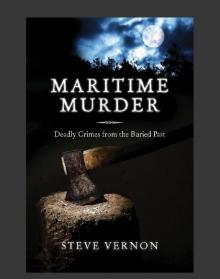- Home
- Steve Vernon
Haunted Harbours
Haunted Harbours Read online
HAUNTED
HARBOURS
HAUNTED
HARBOURS
Ghost Stories
from old Nova Scotia
Steve Vernon
Copyright © Steve Vernon 2006
E-book © 2010
All rights reserved. No part of this book may be reproduced, stored in a retrieval system or transmitted in any form or by any means without the prior written permission from the publisher, or, in the case of photocopying or other reprographic copying, permission from Access Copyright, 1 Yonge Street, Suite 1900, Toronto, Ontario, M5E 1E5.
Nimbus Publishing Limited
PO Box 9166
Halifax, NS B3K 5M8
(902) 455-4286
Printed and bound in Canada
Cover Design: Michael Little, Ideas Ink Design
Interior Design: John van der Woude
Library and Archives Canada Cataloguing in Publication
Vernon, Steve
Haunted harbours : ghost stories from
old Nova Scotia / Steve Vernon.
ISBN 1-55109-592-0
E-book ISBN: 978-1-55109-808-1
1. Ghosts—Nova Scotia. 2. Folklore—Nova Scotia. I. Title.
BF1472.C3V47 2006 398.209716’05 C2006-904151-2
We acknowledge the financial support of the Government of Canada through the Book Publishing Industry Development Program (BPIDP) and the Canada Council, and of the Province of Nova Scotia through the Department of Tourism, Culture and Heritage for our publishing activities.
The past is a ghost,
the future is a dream,
and all that’s precious
lies in between.
CONTENTS
Introduction
1 The Piecemeal Ghost of Black Rock Beach (Halifax)
2 The Restless Spirits of Devil’s Island (Devil’s Island)
3 The Tale of the Young Teazer (Mahone Bay)
4 Old Nick Is Ringing His Bell (Lunenburg)
5 The Ghost-Hunter’s Whistling Ghost (Liverpool)
6 The Jordan Falls Forerunner (Jordan Falls)
7 As Pale As Ice and As Hard As Stone (Mud Island)
8 The Captain’s House at Yarmouth (Yarmouth)
9 The Iron Box at French Cross (Morden)
10 The Piper’s Pond Pibroch (Windsor)
11 The Moose Island Devil (Five Islands)
12 The Weeping Cave of Parrsboro (Parrsboro)
13 The Hidey Hinder of Dagger Woods (Antigonish)
14 The Black Dog of Antigonish Harbour (Antigonish Harbour)
15 The Cape North Selkie (Cape North)
16 The Song of the Pit Pony (Sydney)
17 Blood in the Water, Blood on the Sand (Sable Island)
18 The Phantom Oarsman of Sable Island (Sable Island)
19 The Salt Man of Isaac’s Harbour (Isaac’s Harbour)
20 Big Tony and the Moose (Mushaboom)
21 The Yonderstone of Wittenburg Cemetery (Wittenburg)
Last Words
INTRODUCTION
It was an early October morning and the wind was gossiping with the trees of University Avenue. I could hear Old Man Winter chuckling softly just around the corner of the year, rubbing his icy blue palms together, just tickled at the thought of the great cold and white practical joke he was getting ready to play.
Halifax was just waking up. All across the city people were getting out of bed and sliding slices of Ben’s bread into the mouths of their toasters, frying eggs and pouring cereal and perking good black coffee. The Bedford Highway was already jam-packed with weary motorized pilgrims making their way in. The bridges were equally crowded. Everybody was heading towards work, and I was no exception. I walked into the Public Archives, marched up to the desk, and smiled charmingly at the young woman who sat behind it. There was a man at the bank of computers by the windows, using the Internet. His hair was tinted so many colours that it looked like he’d washed it in a box of crayons. He had so many facial piercings that I wondered if he’d recently fallen face-first into a fistful of fishing tackle.
“Do you have your card?” asked the woman at the desk.
I handed her my Archives identity card, trying very hard not to think of a hundred old war movies with the secret police in menacing trench coats hissing, “Papers, please.”
This wasn’t the first time I’d been here. I’d been researching this collection for more than a year, gathering stories from hearsay and recollection, notes, diaries, and history books. I was used to the security the Archives demanded. They have every right to be careful; there is a lot of irreplaceable information stored inside these heavy stone walls. The Archives has been gathering it since 1929, when Premier Rhodes first laid the cornerstone of the original Studley Campus Archives, with a solid silver masonry trowel. Back then, the Archives were housed in a small stone structure close to the Dalhousie Arts and Administration Building. It was the gift of an anonymous donor who was later “outed” as William H. Chase, the Apple King of Nova Scotia, a good man right down to the core.
In 1980 the old Archives was moved to its current location at 6016 University Avenue, and the old building was turned over to the Mathematics Department of Dalhousie University, which still occupies it.
Which brings me right back to the beginning of my story, which is the proper place to start. I’m a storyteller, born in the woods of the North Canadian Shield. I learned the storytelling tradition from my grandfather. Since he was too old for tag or hide-and-seek, he’d tell me stories and get me to tell them back to him. Nowadays I make a bit of a living working through the Nova Scotia Writers’ Federation’s Writers in the Schools program. I visit schools across the Maritimes, talking to kids from the early grades right on up to high school, teaching them how to tell and write stories.
On this day, I was at the Archives, putting together a collection of Maritime ghost stories. I was a man on a mission, a man with a plan. I stashed my gear in one of the public lockers and took the elevator up to the third floor.
Soon I was buried deep in the pages of a journal from eighteenth-century Halifax.
“Looking for ghosts, are you?”
I looked up, startled by the sound of the voice.
“You’re in the wrong place, you know.”
The owner of that voice was a short and stocky little man, dressed in a rumpled shirt and a pair of dark, battered work pants. He had the wide-legged solid stance of a sailing man who had only recently come to shore.
“I beg your pardon?” I said.
He smiled. It was a good smile, all crackly and warm like a campfire.
“I said you’re in the wrong place if you’re looking for ghosts. There’s no ghosts here in the Archives. There’s nothing here but a lot of facts and figures.”
I understood. You run into this sort of an encounter a lot in libraries and archives. Lonely people in search of a little bit of conversation. I quietly decided to humour him. A working artist could use all of the good karma he could gather.
“My name’s Garnet,” the little man said, “and you’ve got the look of a man who’s looking for ghosts.”
I had to smile at that and wondered how he’d guessed.
“Do I know you?” I asked.
“No sir,” Garnet said. “But I believe I know you.”
I decided that he might have seen my photograph in the news-papers. I’d done a lot of storytelling over the years and had spent a fair bit of my fifteen minutes’ worth of fame in the human interest sections of a half dozen local papers.
“Well, as a matter of fact, that’s just what I’m here for,” I said. “A lot of facts and figures. I’m putting together a collection of Nova Scotian folklore.”
“Aye,” Garnet said, with as broad a brogue as ha
d ever stepped from the Scottish Highlands. “That’s just what I thought. You’re looking for ghosts.”
It was true enough. I was looking for ghost stories.
“Well you won’t find them here,” Garnet repeated. “There’s no room for ghosts in the Archives. There’s no room for mystery in these carefully annotated files and facts and figures. No sir, the only place you’ll find a ghost is in stories.”
I laughed at that.
“I know that,” I said. “I know perfectly well that ghosts aren’t real.”
“I never said they weren’t real; what I said was they’re found in stories. That’s where they like to live. Stories are what feeds them, like a chowder.”
He planted a fist against his hip, a preacher getting set to sermonize. I braced myself for a storm.
“Scientists have yet to tinker a rig so fine that it can calculate the caloric potential of a well-told tale. A handful of good stories can conjure up enough heat to cook up a fine belly-filling chowder. Just add a stone or two, for seasoning.”
I grinned at that. “You’re preaching to the choir,” I said. “I’ve been telling stories for years. Nova Scotia’s got haunted harbours aplenty.”
“Go on,” Garnet said. “You’re too young to call yourself a storyteller.”
“Do you think so?” I asked.
“If I’m wrong, prove it,” Garnet said.
I recognized a challenge when I saw it.
“Come here,” I said. “Let me show you something.”
I took him over to the map case and unrolled a great old map of Halifax.
“Look here,” I said. “See that beach? It’s called Black Rock Beach.”
“If you’re telling a story,” Garnet warned, “don’t stop at one. I crave me an earful.”
“An earful you shall have.”
And I stood there in the heart of the Nova Scotia Archives, and began to tell the tale of Black Rock Beach…
1
THE PIECEMEAL
GHOST OF BLACK
ROCK BEACH
HALIFAX
A local expert in Halifax legal history told me that Halifax’s central gallows were once located at the foot of what is now called George Street, very close to the modern-day ferry terminal. There was also a gallows on the South Common, now the site of the Victoria General Hospital, that was erected back on July 30, 1844, specifically for hanging a gang of convicted pirates.
For a very long time, a set of military gallows, complete with flogging post, stood in the heart of the Citadel Hill parade ground. It was the sight of this gallows and flogging post that prompted Prince Edward’s lover and mistress, Julie de Saint-Laurent, to demand that he build her a separate manor, far away from such ugliness. Prince Edward responded by building the famed Prince’s Lodge, where footpaths spelled out Julie’s name and a brook chuckled merrily down into a heart-shaped pond.
There are still pieces of the public gallows stored at the Old Halifax Courthouse on Spring Garden Road. However, this story concerns another gallows that was erected at Black Rock Beach.
Black Rock Beach is a small open cove at the mouth of the Halifax Harbour, visible from the waterfront parking lot that overlooks Point Pleasant Park. The beach is too shallow to land anything larger than a sloop, but early Halifax settlers found another use for this particular promontory.
Black Rock Beach was the site of one of Halifax’s earliest public gallows. The location was chosen because of its visibility. The gallows was a warning sign to sailors on any ship entering the harbour – this is Halifax, don’t break the law here.
In 1762, Halifax was a pretty lawless place. France was one year away from ceding Canada to Britain, following their defeat in the Seven Years’ War. It was a time of fear and harsh punishments.
A young man stood in the fringe of larch trees overlooking Black Rock Beach, staring at the Black Rock Beach gallows as if he could see his future there. His name was Patrick Tulligan. He was lean, in the way of young men who burn hot and fast. His hair was a wild tangled snarl, caught and knotted by the cold Atlantic wind. He stood in the woods overlooking the beach, staring at the gallows, the timber stark and silhouetted by the setting sun like black burnt bones.
The gallows were a new addition. Before that, the constables had simply dangled criminals from the branch of a standing beach oak. Hangings were more common than you might imagine. One man was hanged for stealing a silver spoon from a downtown tavern where he worked. A year later the spoon was found, beneath the tavern sink where it had fallen.
In fact there were an awful lot of ways to earn yourself a Halifax hanging back in the late 1700s. You could be hanged for offences as varied as murder, treason, rape, manslaughter, arson, highway robbery, polygamy, major theft, firing a gun with intent to injure, cutting a leak hole in a dyke, or unlawful impersonation of another person at a bail hearing. Occasionally, first-time offenders were simply branded with a letter burnt onto the ball of the right thumb. Second-time offenders were automatically hanged.
Patrick stood and stared as any wild young man might, wondering to himself if some day he’d be standing a whole lot closer to that gallows than he’d like.
“You’re looking at your doom, Patrick me lad.”
Patrick turned. He’d been startled by the sudden voice so close to his ears.
It was Mad Meg, who walked the woods with a rope in her hand, searching for a milk cow who’d run off six years past. She was said to have the evil eye, for her one milky yellow left eye stubbornly stared in the wrong direction.
“Are you looking for your cow then, Meg?” Patrick said, unconcerned.
“Aye. She’s not far gone. Just over the hill, I’ll wager. I heard her lowing in the woodlands, and I’m close to catching her.”
Patrick laughed. Not a cruel laugh, but the laugh of a young man who rarely thinks things through.
“Meg, your cow’s been gone for six long years. It’s naught but bones and tangleweed, rotting in the dirt somewhere, or chewing fat grass in some farmer’s pasture, or rendered down to night soil in the bottom of a thieving beggar’s privy.”
Meg fixed him with her yellow eye, pointing at the gallows.
“Look long on that swinging collar of hemp, young Patrick, for you’ll wear it as a forget-me-knot before the last summer wind blows the first leaf of autumn.”
Patrick laughed harder. Meg had been mad long before her cow had wandered off, and few paid her actions any heed. Still, it was whispered that she had the gift of second sight. Some swore she had the evil eye and could jinx anyone she didn’t care for.
“You’ll hang for three long decades and linger longer, I’ll war-rant.”
He touched his fingertips to his collar, feeling the stubborn knot of his Adam’s apple quivering beneath his outstretched thumb. Her words scared him, but he laughed to mask his fear. “Ha!” he scoffed. “How long can a rope hang?”
Meg wrapped her bit of cow-rope about her neck and curtseyed. “Long as memory. Longer than time. Longer than the tail of the wind.”
And then she turned and ran like an out-of-control windstorm. In a beat of a bird’s wing she was gone, vanished like smoke up a chimney hole.
If he was rattled, Patrick wouldn’t show it. He’d hand-hauled codfish and had nearly died in a half a dozen storms at sea. He’d stood and scrapped toe to toe with the biggest sailors this side of the Atlantic. Some he’d beaten and some had beaten him, but none ever dared call him a coward.
He walked the long path back to Halifax with the straps of his gunny sack chafing against his work-hardened shoulders, not realizing how soon it would be that he’d walk this path again and in what manner he would be forced to walk it.
Back then, as now, the streets of Halifax all rolled down to the sea to the harbour front, where the nastiest taverns poured the thinnest of ales and the women’s laughter sounded like the clatter of coins. Halifax was a port city. Like today, there were plenty of places for a sailor to spend his money. Folks came and w
ent like the passing of the tides. Everybody expected a profit.
Patrick had a girlfriend named Belinda Marywell, better known as “Belle of the Isle.” Belinda was born and raised on McNabs Island. He’d been seeing her for three months, a long time for a lad who’d once sworn he’d never be tied down.
“You’ll stand before a preacher, yet,” Belinda swore.
“I’ll face the hangman first,” Patrick allowed.
That night Patrick danced a jig, and not feeling the dark eyes of the innkeeper hanging upon the two of them, stole a kiss from Belinda.
The innkeeper, one Thomas Tanner, was a fat man with an evil disposition. He’d set his heart on the beautiful Belle of the Isle, and vowed she’d be his wife. But Patrick was too tough and had too many friends for Tanner to risk an open confrontation. Besides, there were better ways to get around an obstacle like Patrick.
“You’ll dance your next jig on a higher dance floor than this,” Tanner swore.
One summer day a ship was robbed and sunk just off Devil’s Island. The magistrates searched every tavern for likely suspects. It was an election year, and they were taking no chances. Thomas Tanner was more than glad to help them out. Palms were greased and strings tugged, and Patrick was sentenced for piracy.
Now everyone knew that Patrick, though a wild boy, was certainly no pirate. But the magistrates closed ranks about Tanner’s testimony and would hear not one word in young Patrick’s defense.
“You shall be whipped at the cart’s tail to Black Rock Beach, where you will hang by the neck until death,” the judge pronounced, yet all Patrick could hear was the laughter of old Meg taunting him with her prophecy.
The town guard led Patrick down to Black Rock Beach with his hands tied to the back end of an ox cart, whipping him with a great long leather lash. They beat him every step of the way down to the gallows, a guardsman following behind Patrick’s cart, laying his whip across Patrick’s bare back. Down at the beach they slid the noose about Patrick’s throat, snugging it closely to be certain that the knot would snap his neck properly.
Patrick looked wildly about in the crowd that had gathered to watch him drop, searching in vain for the long auburn tresses of his Belle of the Isle. She was nowhere in sight. All that he saw was the crowd, headed by the fat and smirking Thomas Tanner— and high on the slope of the hill looking down on the scene was Mad Meg. She waved her cow rope like a goodbye hankie at young Patrick. The last sound Patrick heard was Meg’s laughter rising up like the call of the seagulls over the ever-returning tide.

 Flash Virus: Episode One
Flash Virus: Episode One Cat Tales Issue #3
Cat Tales Issue #3 Cat Tales Issue #1
Cat Tales Issue #1 A Fine Sacrifice
A Fine Sacrifice The Lunenburg Werewolf
The Lunenburg Werewolf October Tales: Seven Creepy Stories (Stories to SERIOUSLY Creep You Out Book 1)
October Tales: Seven Creepy Stories (Stories to SERIOUSLY Creep You Out Book 1) Roadside Ghosts: A Collection of Horror and Dark Fantasy (Stories to SERIOUSLY Creep You Out Book 3)
Roadside Ghosts: A Collection of Horror and Dark Fantasy (Stories to SERIOUSLY Creep You Out Book 3) Haunted Harbours
Haunted Harbours Wicked Woods
Wicked Woods Two Fisted Nasty: A Novella and Three Short Stories (Stories to SERIOUSLY Creep You Out Book 2)
Two Fisted Nasty: A Novella and Three Short Stories (Stories to SERIOUSLY Creep You Out Book 2) A Hat Full of Stories: Three Weird West Tales (Stories to SERIOUSLY Creep You Out Book 9)
A Hat Full of Stories: Three Weird West Tales (Stories to SERIOUSLY Creep You Out Book 9) Bad Valentines: three twisted love stories (Stories To SERIOUSLY Creep You Out Book 7)
Bad Valentines: three twisted love stories (Stories To SERIOUSLY Creep You Out Book 7) Do-Overs and Detours - Eighteen Eerie Tales (Stories to SERIOUSLY Creep You Out Book 4)
Do-Overs and Detours - Eighteen Eerie Tales (Stories to SERIOUSLY Creep You Out Book 4) Tales From The Tangled Wood: Six Stories to SERIOUSLY Creep You Out
Tales From The Tangled Wood: Six Stories to SERIOUSLY Creep You Out Sinking Deeper
Sinking Deeper Bad Valentines 2: Six Twisted Love Stories (Stories to SERIOUSLY Creep You Out Book 5)
Bad Valentines 2: Six Twisted Love Stories (Stories to SERIOUSLY Creep You Out Book 5) Big Hairy Deal
Big Hairy Deal Maritime Murder
Maritime Murder Rueful Regret
Rueful Regret